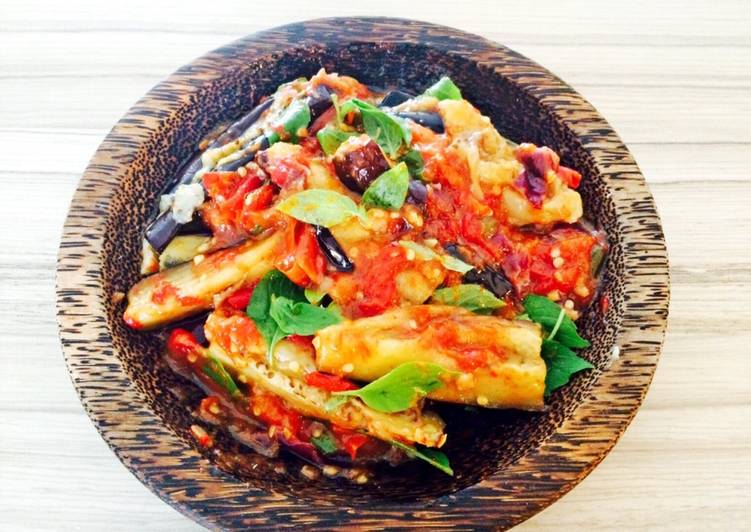
Hey everyone, it’s Jim, welcome to our recipe site. Today, I’m gonna show you how to prepare a special dish, balado terong - aubergine with chili sauce. One of my favorites food recipes. This time, I’m gonna make it a little bit tasty. This is gonna smell and look delicious.
Balado terong - Aubergine with chili sauce is one of the most well liked of recent trending meals in the world. It is simple, it is fast, it tastes delicious. It’s appreciated by millions every day. They are fine and they look wonderful. Balado terong - Aubergine with chili sauce is something which I have loved my entire life.
Balado terong - Aubergine with chili sauce Balado is a red hot spicy sauce that you can use to stir fry all kind of food, with prawns, squids, eggs, potatoes and aubergine being the most popular choice. And balado terong is one of famous sambal recipes in Indonesia. Balado is a red hot spicy sauce that you can use to stir fry all kind of food, with prawns, squids, eggs, potatoes, and eggplants being the most popular choice. I'll share with you how to prepare terong balado (eggplants with chili sauce) in this recipe, but feel free to use it any way you like it.
To begin with this particular recipe, we must prepare a few components. You can cook balado terong - aubergine with chili sauce using 12 ingredients and 6 steps. Here is how you cook that.
The ingredients needed to make Balado terong - Aubergine with chili sauce:
- Make ready 1 aubergine
- Prepare 5 big red chilies (more or less, depend on how spicy you like)
- Make ready 3 shallots
- Make ready 2 garlic cloves
- Prepare 1 tomato
- Get 100 ml vegetable oil
- Get 1 tsp salt or to taste
- Make ready 1 tsp sugar or to taste
- Make ready 1 bay leave
- Take 1 kaffir lime leave
- Get 1 tsp lime juice
- Get 1 handful lemon basil for garnish (optional)
Add chopped tomato and cook until tomato just wilted. Terong Balado (Eggplant in Spicy Chili Sauce) originated from Padang, the western part of Sumatra island in Indonesia. The dishes from that region are always spicy and hot. There are many variations of balado (spicy chili sauce).
Steps to make Balado terong - Aubergine with chili sauce:
- Wash the aubergine, remove the cap and cut it lengthwise (unpeeled). Soak in cold water that has been sprinkled with plenty of salt to prevent aubergine flesh from turning into brown color.
- Heat vegetable oil in a wok on high heat. Pat dry aubergine and fry for about 2 minutes to bring out the color. Drain over a wire rack to remove excess oil and set aside.
- The spice paste : Put chilies, shallots, garlic and tomato in a food processor and blend until smooth. Add a little bit oil to help the blending process. Put aside.
- Remove the oil from the wok and leave about 2 tablespoons of oil. Heat the oil and stir fry the spice paste, bay leave, kaffir lime leave, salt and sugar until fragrant, about 2-3 minutes.
- Adjust the taste. Add salt if necessary. Add the lime juice and stir to mix.
- Toss in the fried aubergine for another 2 minutes. Remove from the heat and garnish with lemon basil leaves. Serve with steamed rice.
The dishes from that region are always spicy and hot. There are many variations of balado (spicy chili sauce). Balado is a red hot spicy sauce that you can use to stir fry all kind of food, with prawns, squids, eggs, potatoes, and eggplants being the most popular choice. I'll share with you how to prepare terong balado (eggplants with chili sauce) in this recipe, but feel free to use it any way you like it. How to prepare eggplants for a balado Place chile peppers, onion, tomato, and garlic in a food processor.
So that is going to wrap this up with this special food balado terong - aubergine with chili sauce recipe. Thanks so much for reading. I’m sure that you will make this at home. There’s gonna be interesting food at home recipes coming up. Don’t forget to save this page in your browser, and share it to your family, friends and colleague. Thank you for reading. Go on get cooking!


